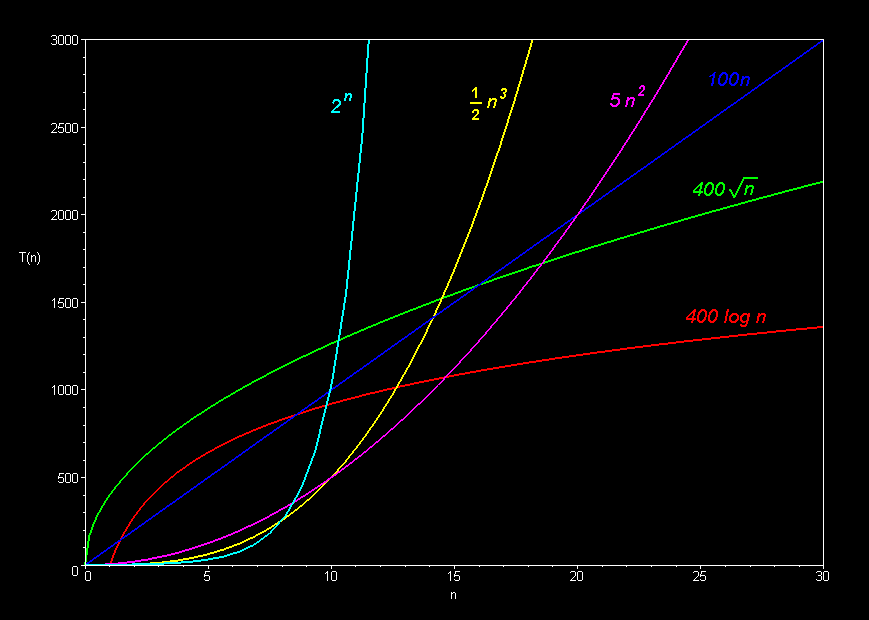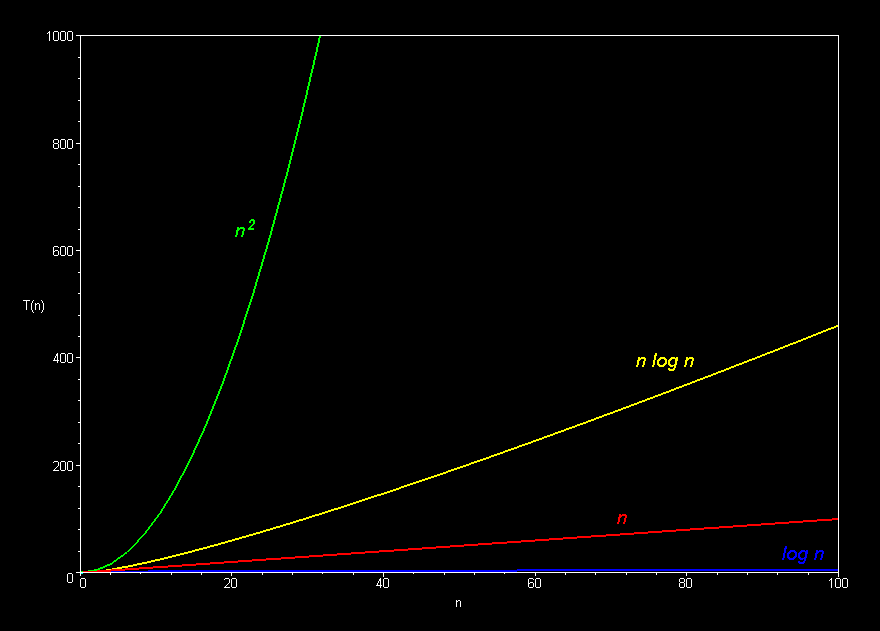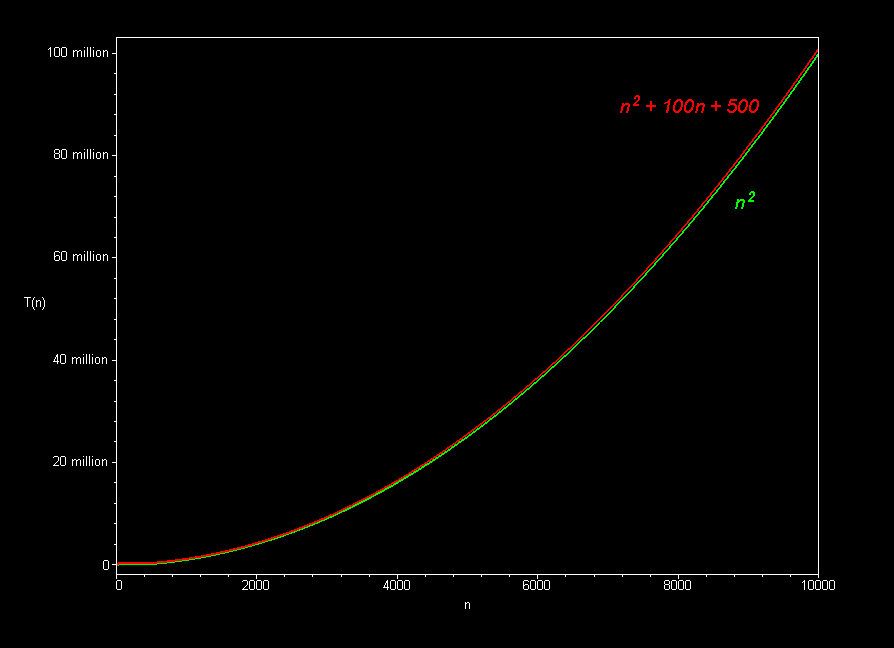CMU 15-112: Fundamentals of Programming and Computer Science
Class Notes: Efficiency
- Big-O
- Describes behavior of a function as the size of its input grows
- Informally (for 15112): ignore all lower-order terms and constants
- Formally (after 15112): see here
- A few examples in math functions:
- 3n2 - 2n + 25 is O(n2)
- 30000n2 + 2n - 25 is O(n2)
- 0.00000000001n2 + 123456789n is O(n2)
- 10nlog17n + 25n - 17 is O(nlogn)
- Common Function Families
- Constant O(1)
- Logarithmic O(logn)
- Square-Root O(n0.5)
- Linear O(n)
- Linearithmic, Loglinear, or quasilinear O(nlogn)
- Quadratic O(n2)
- Exponential O(kn)
- Efficiency
When we say the program runs in O(N), we mean...- N is the size of our input
- For a string s, N = len(s)
- For a list lst, N = len(lst) (also true for sets, dictionaries, and other collections)
- For an integer n, N = n
- We can technically calculate Big-O for a number of program attributes, like time, space, bandwidth, etc. But in this class, we mainly care about time.
- For time, we usually measure algorithmic steps rather than elapsed time (These share the same Big-O, but algorithmic steps are easier to precisely describe and reason over)
- Algorithmic steps could be single lines of computation, or comparisons and swaps in a list, etc
- Can verify by timing your code's execution with: time.time()
- N is the size of our input
- Note that you can measure worst-case or average case, or even other cases such as best case (which often is trivial to compute and not very useful in practice). For 15-112, we often omit this term (which is a notable simplification that you will not see in future courses), and we nearly always mean worst-case, which is quite useful and generally easier to compute than average-case.
- The Big Idea
- Each function family grows much faster than the one before it!
- And: on modern computers, any function family is usually efficient enough on small n, so we only care about large n
- So... Constants do not matter nearly as much as function families
- Practically...
- Do not prematurely or overly optimize your code
- Instead: think algorithmically!!!
- Examples
- Sequences, Nesting, and Composition
- Sequencing
# what is the total cost here? L = [ 52, 83, 78, 9, 12, 4 ] # assume L is an arbitrary list of length N L.sort() # This is O(NlogN) L.sort(reverse=True) # This is O(NlogN) L[0] -= 5 # This is O(1) print(L.count(L[0]) + sum(L)) # This is O(N) + O(N) - Nesting
# what is the total cost here? L = [ 52, 83, 78, 9, 12, 4 ] # assume L is an arbitrary list of length N for c in L: # This loop's body is executed O(N) times L[0] += c # This is O(1) L.sort() # This is O(NlogN) print(L) # This is O(N) (why?) - Composition
# what is the total cost here? def f(L): # assume L is an arbitrary list of length N L1 = sorted(L) # This is O(NlogN) return L1 # This is O(1) def g(L): # assume L is an arbitrary list of length N L1 = L * len(L) # This is O(N**2) (why?) return L1 # This is O(1) L = [ 52, 83, 78, 9, 12, 4 ] # assume L is an arbitrary list of length N L = f(g(L)) # What is the Big-O of this? print(L) # This is O(N**2) (why?)
- Sequencing
- Sequences, Nesting, and Composition
- Python Builtins
The efficiency of the built-in functions in Python will affect the efficiency of the functions they are used in. We do not expect you to memorize the builtin efficiencies; instead, you may look them up in the table provided below when needed. We will include the relevant subset of this table on quizzes and exams.
General Function/Method Complexity Code Example Print O(N) # where N is the size of the input print(input)
Range in Iteration Number of iterations = (end - start)/step for i in range(start, end, step):...
Strings: s is a string with N characters Function/Method Complexity Code Example Len O(1) len(s)
Membership O(N) "a" in s
Get single character O(1) value = s[index]
Get slice O(end - start) s[start:end]
Get slice with step O((end - start)/step) s[start:end:step]
Chr() and Ord() O(1) chr(s) ord(s)
Concatentation O(len(s1) + len(s2)) s3 = s1 + s2
Character Type Methods O(N) s.isalnum() s.isalpha() s.isdigit() s.islower() s.isspace() s.isupper()
String Edit Methods O(N) s.lower() s.upper() s.replace() s.strip()
Substring Search Methods O(N) s.count() s.startswith() s.endswith() s.find() s.index()
Lists: L is a list with N elements Function/Method Complexity Code Example Len O(1) len(L)
Append O(1) L.append(value)
Extend O(K) # len(a) = K L.extend(a)
Concatentation with += O(K) # len(a) = K L += a
Concatentation with + O(N + K) # len(a) = K L = L + a
Membership Check O(N) item in L
Pop Last Value O(1) L.pop()
Pop Intermediate Value O(N) L.pop(index)
Count values in list O(N) L.count(item)
Insert O(N) L.insert(index, value)
Get value O(1) value = L[index]
Set value O(1) L[index] = value
Remove O(N) L.remove(value)
Get slice O(end - start) L[start:end]
Get slice with step O((end - start)/step) L[start:end:step]
Sort O(N log (N)) L.sort() sorted(L)
Multiply O(N*D) #where D is an int A = L*D
Minimum O(N) min(L)
Maximum O(N) max(L)
Copy O(N) copy.copy(L)
Deep Copy O(N*M) # where L is a 2D list with N rows and M cols copy.deepcopy(L)
Sets: s is a set with N elements Function/Method Complexity Code Example Len O(1) len(s)
Membership O(1) elem in s
Adding an Element O(1) s.add(elem)
Removing an Element O(1) s.remove(elem) s.discard(elem)
Union O(len(s) + len(t)) s|t
Intersection O(min(len(s), len(t))) s&t
Difference O(len(s)) s - t
Clear O(len(s)) s.clear()
Copy O(len(s)) s.copy()
Dictionaries: d is a dictionary with N key-value pairs Function/Method Complexity Code Example Len O(1) len(d)
Membership O(1) key in d
Get Item O(1) value = d[key] d.get(key, defaultValue)
Set Item O(1) d[key] = value
Delete Item O(1) del d[key]
Clear O(N) d.clear()
Copy O(N) d.copy()
For a more complete list, see here - sumOfSquares Examples
Note: Run this code in Standard Python, as it will timeout if you run it in brython.# The following functions all solve the same problem: # Given a non-negative integer n, return True if n is the sum # of the squares of two non-negative integers, and False otherwise. def f1(n): for x in range(n+1): for y in range(n+1): if (x**2 + y**2 == n): return True return False def f2(n): for x in range(n+1): for y in range(x,n+1): if (x**2 + y**2 == n): return True return False def f3(n): xmax = int(n**0.5) for x in range(xmax+1): for y in range(x,n+1): if (x**2 + y**2 == n): return True return False def f4(n): xyMax = int(n**0.5) for x in range(xyMax+1): for y in range(x,xyMax+1): if (x**2 + y**2 == n): return True return False def f5(n): xyMax = int(n**0.5) for x in range(xyMax+1): y = int((n - x**2)**0.5) if (x**2 + y**2 == n): return True return False def testFunctionsMatch(maxToCheck): # first, verify that all 5 functions work the same print("Verifying that all functions work the same...") for n in range(maxToCheck): assert(f1(n) == f2(n) == f3(n) == f4(n) == f5(n)) print("All functions match up to n =", maxToCheck) testFunctionsMatch(100) # use larger number to be more confident import time def timeFnCall(f, n): # call f(n) and return time in ms # Actually, since one call may require less than 1 ms, # we'll keep calling until we get at least 1 secs, # then divide by # of calls we had to make calls = 0 start = end = time.time() while (end - start < 1): f(n) calls += 1 end = time.time() return float(end - start)/calls*1000 #(convert to ms) def timeFnCalls(n): print("***************") for f in [f1, f2, f3, f4, f5]: print ("%s(%d) takes %8.3f milliseconds" % (f.__name__, n, timeFnCall(f, n))) timeFnCalls(1001) # use larger number, say 3000, to get more accurate timing
Graphically (Images borrowed from here):


